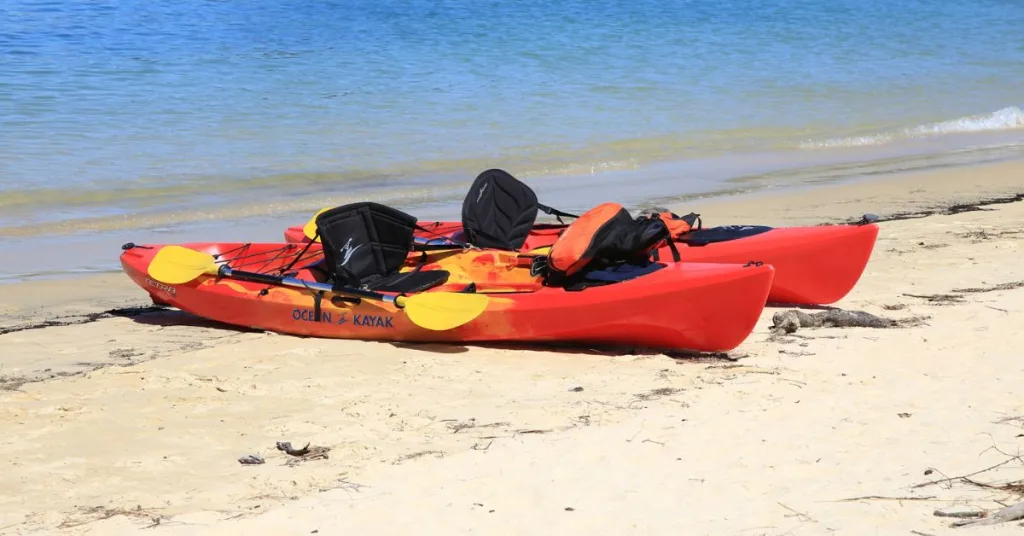When planning your next kayaking adventure, it’s crucial to consider the weight capacity of your kayak. Whether you’re a seasoned paddler or a beginner, understanding how weight limits work ensures both your safety and your enjoyment on the water. In this article, we’ll dive into the importance of kayak weight limits, how they affect your kayaking experience, and tips for choosing the right kayak based on its weight capacity.

Understanding Kayak Weight Limits
Every kayak comes with a specified weight limit, which refers to the maximum weight the kayak can safely carry. This includes your body weight, gear, and any additional accessories you might bring along. Exceeding this limit can lead to instability, making your kayak harder to maneuver and potentially increasing the risk of capsizing. Knowing the weight limit helps in planning your trip better, ensuring that you bring only necessary items and avoid overloading.
Beyond safety, weight limits are an integral part of the kayak’s design, impacting its overall performance on the water. A kayak’s ability to glide, track, and respond to paddler inputs can be greatly diminished if overloaded. This underscores the importance of not just knowing but respecting the weight capacity to maintain the kayak’s intended performance characteristics.
How Weight Limits Are Determined
Manufacturers conduct rigorous tests to determine a kayak’s weight capacity. These tests consider the kayak’s design, materials, and intended use. For instance, a kayak designed for fishing may have a higher weight capacity to accommodate fishing gear and a larger paddler, while a lightweight racing kayak will have a lower capacity to maintain speed and agility. These tests often involve simulating different conditions to ensure the kayak can handle the specified weight under various scenarios.
The process involves assessing the buoyancy, stability, and structural integrity of the kayak under maximum loads. Advanced modeling and real-world testing help manufacturers set a reliable weight limit that buyers can trust. The thoroughness of these tests means that the weight limits provided by manufacturers are critical for ensuring both safety and performance.
Why Kayak Weight Capacity Matters
Safety First
The primary reason for adhering to a kayak’s weight limit is safety. Overloading a kayak can make it less stable, increasing the likelihood of tipping over. This is particularly important in rough waters or when navigating through waves and currents. By respecting the weight limit, you can ensure a more stable and safer kayaking experience. Safety should always be your top priority, and understanding weight limits is a fundamental part of risk management on the water.
Additionally, in emergencies, an overloaded kayak can hinder your ability to react quickly or perform necessary maneuvers. This can be especially perilous in conditions that demand quick reflexes and precise handling. Thus, staying within the weight limit is a proactive measure to mitigate potential dangers.
Performance and Handling
A kayak’s weight capacity also affects its performance. When a kayak is overloaded, it sits lower in the water, increasing drag and making it harder to paddle. This can lead to fatigue and reduce your overall enjoyment. Staying within the weight limit ensures that your kayak performs optimally, allowing you to paddle efficiently with less effort. Proper weight distribution also enhances your control over the kayak, making it more responsive to your inputs.
Furthermore, maintaining the appropriate weight improves the kayak’s speed and tracking ability. This not only makes your paddling more enjoyable but also more efficient, conserving your energy for longer trips or more challenging waters. The balance between weight and performance is crucial for both competitive paddlers and recreational users.
Longevity of Your Kayak
Repeatedly exceeding the weight limit can cause long-term damage to your kayak. The additional stress can lead to cracks or warping, especially in plastic or composite models. By keeping within the recommended capacity, you extend the life of your kayak, protecting your investment. A well-maintained kayak not only offers years of service but also retains its value better over time.
In addition to structural damage, overloading can compromise other components such as seats, hatches, and footrests. Regularly pushing the weight limits may require more frequent repairs or replacements, which can be costly. Thus, adhering to weight guidelines is also a practical approach to minimizing maintenance and maximizing the lifespan of your kayak.
Factors Influencing Kayak Weight Capacity

Design and Material
Kayaks come in various shapes and sizes, each designed for specific purposes. Touring kayaks, sit-on-top kayaks, and inflatable kayaks all have different weight capacities based on their design and materials. For example, an inflatable kayak might have a lower weight limit compared to a hard-shell kayak due to the materials used. The construction materials, whether polyethylene, fiberglass, or carbon fiber, play a pivotal role in determining the weight capacity.
Moreover, design elements such as hull shape and cockpit size also influence a kayak’s weight capacity. A wider hull may offer more stability and a higher weight limit, while a sleek, narrow design prioritizes speed and agility. Understanding these nuances helps in selecting a kayak that aligns with your specific needs and activities.
Intended Use
The intended use of a kayak plays a significant role in determining its weight capacity. Fishing kayaks, designed to carry extra gear and tackle, generally have higher weight limits. Conversely, recreational kayaks, which are often lighter and more compact, may have lower capacities. The type of water you plan to navigate, whether calm lakes or turbulent rivers, also influences the choice of kayak and its required weight capacity.
Additionally, the type of activities you engage in, such as long-distance touring or day trips, will dictate the necessary gear and thus affect your weight considerations. By aligning the kayak’s intended use with your personal paddling goals, you can make a more informed choice.
Kayak Type
There are several types of kayaks, each catering to different activities and environments. Understanding the type of kayak that suits your needs will help you choose one with an appropriate weight capacity.
- Recreational Kayaks: Great for calm waters and short trips, these kayaks typically have lower weight capacities. They offer ease of use and are perfect for beginners or casual paddlers exploring tranquil environments.
- Touring Kayaks: Designed for longer journeys, they often boast higher weight limits to accommodate additional gear. Their design focuses on efficiency and comfort over extended periods on the water.
- Fishing Kayaks: Built to hold extra equipment, these kayaks usually offer the highest weight capacities. They are equipped with features like rod holders and additional storage, making them ideal for anglers.
- Whitewater Kayaks: Meant for navigating rapids, these kayaks prioritize agility over carrying capacity. Their design allows for quick turns and maneuvers, essential for challenging whitewater conditions.
Tips for Choosing the Right Kayak

Assess Your Needs
Before selecting a kayak, consider the type of activities you plan to engage in and the gear you’ll need. This will help you determine the appropriate weight capacity for your kayak. Reflect on your paddling habits, whether you’ll be embarking on solo trips or group excursions, and the environments you plan to explore.
Furthermore, consider the frequency of use and how your kayaking needs might evolve. A versatile kayak with a balanced weight capacity can accommodate future adventures and growing skills, ensuring you get the most value from your purchase.
Calculate Total Load
Add up your body weight and the weight of any gear you plan to carry. This total should be well within the kayak’s weight capacity, ideally allowing for a margin of safety. Factor in additional items like water, snacks, and safety equipment, which can add significant weight.
Leaving a buffer also accounts for any unplanned items or changes in conditions, such as water absorption in certain materials. This proactive approach to load calculation helps prevent overloading and ensures a smoother experience on the water.
Test Before You Buy
If possible, test different kayaks to see how they handle with your intended load. Many kayak rental services offer a variety of models to try before you make a purchase. This hands-on experience provides valuable insights into the kayak’s performance, comfort, and handling.
Testing also allows you to experiment with different weight distributions and seating positions, helping you find the optimal setup for your paddling style. This trial phase is instrumental in making an informed decision that you won’t regret later.
Consult Experts
Don’t hesitate to ask for advice from kayak retailers or experienced paddlers. They can provide insights into which models and capacities might best suit your needs. Experienced paddlers can share firsthand experiences and tips that aren’t always apparent in product specifications or reviews.
Retailers often have in-depth knowledge of their products and can guide you through the technical aspects, helping you understand the trade-offs between different kayaks. Leveraging their expertise can save you time and effort in finding the perfect kayak.
Conclusion
Understanding the weight limit of a kayak is essential for safe and enjoyable paddling. By considering factors such as design, intended use, and your personal needs, you can choose a kayak that offers the right balance of performance and safety. Always respect the weight capacity to ensure a stable and efficient kayaking experience, and remember that a well-chosen kayak can lead to countless hours of fun on the water.
Whether you’re exploring tranquil lakes or tackling challenging rapids, knowing your kayak’s weight limit helps you make the most of your time on the water. So, pack wisely, paddle safely, and enjoy the adventure that awaits! Equip yourself with knowledge and preparation, and you’ll find that kayaking can be a rewarding and exhilarating way to connect with nature.
Also Read
